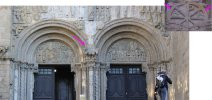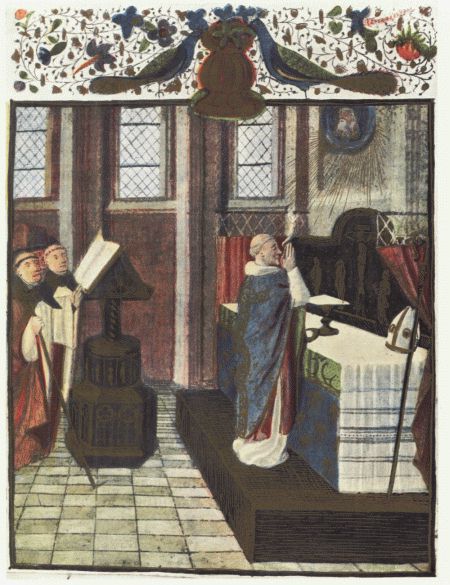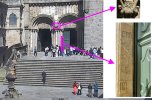Stuart arthur
New Member
- Time of past OR future Camino
- October 2011
can someone tell me what are the words in Latin that are above the main door to the cathedral. It will contain the words alpha and omega And refers to the end is the beginning

| Remove ads on the forum by becoming a donating member. More here. |
|---|
It is not an inscription in Latin but a sculpture - known as a Chrismon - on the south portal of the Cathedral of Santiago. The Cathedral's website describes and interprets it with these words:It will contain the words alpha and omega And refers to the end is the beginning

Give us the script in Latin and we’ll be on it like a tramp on chips, as my maternal grandmother might have said.can someone tell me what are the words in Latin that are above the main door to the cathedral. It will contain the words alpha and omega And refers to the end is the beginning
The Alpha has changed places with the Omega. The end is at the beginning. The goal of el Camino has now started another Camino, you have started a new life.
As ever, your sleuth credentials are impeccable. thank you. The last line of the quote from wiki is indeed the alpha and the omega.It is not an inscription in Latin but a sculpture - known as a Chrismon - on the south portal of the Cathedral of Santiago. The Cathedral's website describes and interprets it with these words:
Starting the Pilgrimage of LifeWhen you finish, leave the cathedral through the southern door, La Puerta de las Platerías. Focus on the facade. On the mullion between the arch of the two doors, there is a Crismón, a monogram of Christ. But the letters are backwards: The Alpha has changed places with the Omega. The end is at the beginning. The goal of el Camino has now started another Camino, you have started a new life.View attachment 161604
A Chrismon is a familiar motif in Christian religious art. Usually, the Greek letter alpha is placed on the left and the letter omega is on the right but it can also be inverse as in this case. As with many expressions in art, one can attribute all sorts of meanings to it. Whether the interpretation on the Cathedral's website was originally intended is anyone's guess. Here is a link to the meaning of the expression "I am the alpha and the omega" in a Christian context: https://en.wikipedia.org/wiki/Alpha_and_Omega
During the Pilgrim‘s Mass you can often hear words to the effect that the end of your camino to Santiago is the start of the camino of your new life.
What do you mean by "the main door" to the cathedral? North, south, east, or west? Can you link to a photo or a written copy of the words you are referring to?can someone tell me what are the words in Latin that are above the main door to the cathedral. It will contain the words alpha and omega And refers to the end is the beginning
Thank you. No sleuthing this time, just calling up information stored in my memory banks that still function, sometimes to my surprise and relief.As ever, your sleuth credentials are impeccable. thank you. The last line of the quote from wiki is indeed the alpha and the omega.
I don't think you'll ever get all your work done @Kathar1na. Thank you for that.So all I had to do is make two screenshots, put them together, and add a few links and my work was done.
Thinking about this, will 2077 and 2078 be another double Holy Year ?There is another Latin inscription at the Holy Door :
ERA / IC / XVI / V IDUS / JULLII
This is a date given in the Roman calendar, July 11, 1078. It commemorates the laying of the first stone in the construction of that entrance.
The "Main" entry doors to the Cathedral are on the West facade, facing Plaza Obradoiro and the Raxoi Palace. Traditionally, most old churches and cathedrals were built with the altar - and celebrant - facing East.What do you mean by "the main door" to the cathedral? North, south, east, or west? Can you link to a photo or a written copy of the words you are referring to?
The reason that I asked which door the OP meant is that we cannot enter the cathedral by the main, i.e. west, door, the Pórtico da Gloria. So the south door may be now considered the main door. I was told, years ago. that churches in England were orientated east-west so that we would be facing Jerusalem when we were facing the altar. This always seemed to be nonsense, as Jerusalem is south-east of England. The angle from London is 127°, but it obviously varies from the south of England to the north of England.The "Main" entry doors to the Cathedral are on the West facade, facing Plaza Obradoiro and the Raxoi Palace. Traditionally, most old churches and cathedrals were built with the altar - and celebrant - facing East.
I do not know the genus of this practice. Perhaps someone could clue me in. But, in my layman's observations over the years, it DOES seem that most Catholic and mainline Protestant churches are aligned with the altar end is on the East facing side of the church.
I accept ignorance, if someone wishes to educate me, I would appreciate it.
Thanks
Tom
Google ‘orientation of churches’ Tom, it’s all there; and you’re correct it’s common for churches to be orientated such that the object of worship - the altar - is in the east; ‘the orient’.The "Main" entry doors to the Cathedral are on the West facade, facing Plaza Obradoiro and the Raxoi Palace. Traditionally, most old churches and cathedrals were built with the altar - and celebrant - facing East.
I do not know the genus of this practice. Perhaps someone could clue me in. But, in my layman's observations over the years, it DOES seem that most Catholic and mainline Protestant churches are aligned with the altar end is on the East facing side of the church.
I accept ignorance, if someone wishes to educate me, I would appreciate it.
Thanks
Tom
I expect that it is so the celebrant is facing the Holy Land. I wonder if it is different in churches east of the Holy Land.The "Main" entry doors to the Cathedral are on the West facade, facing Plaza Obradoiro and the Raxoi Palace. Traditionally, most old churches and cathedrals were built with the altar - and celebrant - facing East.
I do not know the genus of this practice. Perhaps someone could clue me in. But, in my layman's observations over the years, it DOES seem that most Catholic and mainline Protestant churches are aligned with the altar end is on the East facing side of the church.
I accept ignorance, if someone wishes to educate me, I would appreciate it.
Thanks
Tom
I second this suggestion.Google ‘orientation of churches’
We're not Muslims and we do not face towards material locations, except the altars in our churches.I expect that it is so the celebrant is facing the Holy Land. I wonder if it is different in churches east of the Holy Land.
I second this suggestion.
Or look up Wikipedia on 'Orientation of churches'. The Wiki article in English has the basics, the Wiki articles in French and German have more interesting details.

I stand corrected. In my defence, it is not only Muslims that face east towards a physical location. Jews do, too (unless they are east of Jerusalem). And the very fact of pilgrimages shows that the Church cares about physical locations. I don't think it was farfetched to suppose there might be an orientation of worship towards the location of the Crucifixion and Resurrection.We're not Muslims and we do not face towards material locations, except the altars in our churches.
Ad oriens is towards the Dawn, and so as much towards the Resurrection in sunrise as towards the Eternal Light of God.
I am somewhat surprised that even some well-experienced pilgrims are so confused about such basics.
OK I can see that, but Christian worship is not directed to places as such ; though in Eucharist, it is directed towards the Real Presence, which is physically located but not in one location only.I stand corrected. In my defence, it is not only Muslims that face east towards a physical location. Jews do, too (unless they are east of Jerusalem). And the very fact of pilgrimages shows that the Church cares about physical locations. I don't think it was farfetched to suppose there might be an orientation of worship towards the location of the Crucifixion and Resurrection.
It may not be far fetched to suppose so but the association does not exist - certainly not today and also not in the Middle Ages when most of the churches were built that are still standing and were built lengthwise with (roughly) an east-west axis.I don't think it was farfetched to suppose there might be an orientation of worship towards the location of the Crucifixion and Resurrection.
That's why I was ready to stand corrected. I am not immune to being in error and quite willing to accept it the many times it occurs.It may not be far fetched to suppose so but the association does not exist - certainly not today and also not in the Middle Ages when most of the churches were built that are still standing and are built lengthwise with (roughly) an east-west axis.
The most common association and interpretation says that the east stands for sunrise which in turn is a symbol for the Resurrection (of Jesus) and/or the future resurrection of the faithful - also that Christ will appear from the east on Judgment Day and that the Heavenly Jerusalem aka the New Jerusalem and/or Paradise are in the east. These are ideas that medieval people were probably more familiar with than we are today.
It is not about the terrestrial Jerusalem in the Middle East.

I respectfully refute this allegation.This whole side discussion started with someone saying that he “was told, years ago. that churches in England were orientated east-west so that we would be facing Jerusalem when we were facing the altar. This always seemed to be nonsense, as Jerusalem is south-east of England.“
One should not believe everything that one is told or that one reads on social media.
I respectfully refute this allegation.
The excavated ruins in Lugo give us some clue: first churches were often built using sites of previous temples and a "kind of" architectural syncretism followed from there. Indeed the apparent temple to Mithras uncovered in Lugo was used as a church and the floor plan and later arrangement are pretty much indistinguishable in terms of orientation and design to any Romanesque church with the usual alter and celebrant (or priest in our parlance) facing east, and the main entry being at the western end of the building.The "Main" entry doors to the Cathedral are on the West facade, facing Plaza Obradoiro and the Raxoi Palace. Traditionally, most old churches and cathedrals were built with the altar - and celebrant - facing East.
I do not know the genus of this practice. Perhaps someone could clue me in. But, in my layman's observations over the years, it DOES seem that most Catholic and mainline Protestant churches are aligned with the altar end is on the East facing side of the church.
I accept ignorance, if someone wishes to educate me, I would appreciate it.
Thanks
Tom
This interpretation has definitely become part of contemporary pilgrimage lore.It is sometimes interpreted as the end of your camino is the beginning of your new camino in your life but this was not on the minds of the medieval designers and architects.


